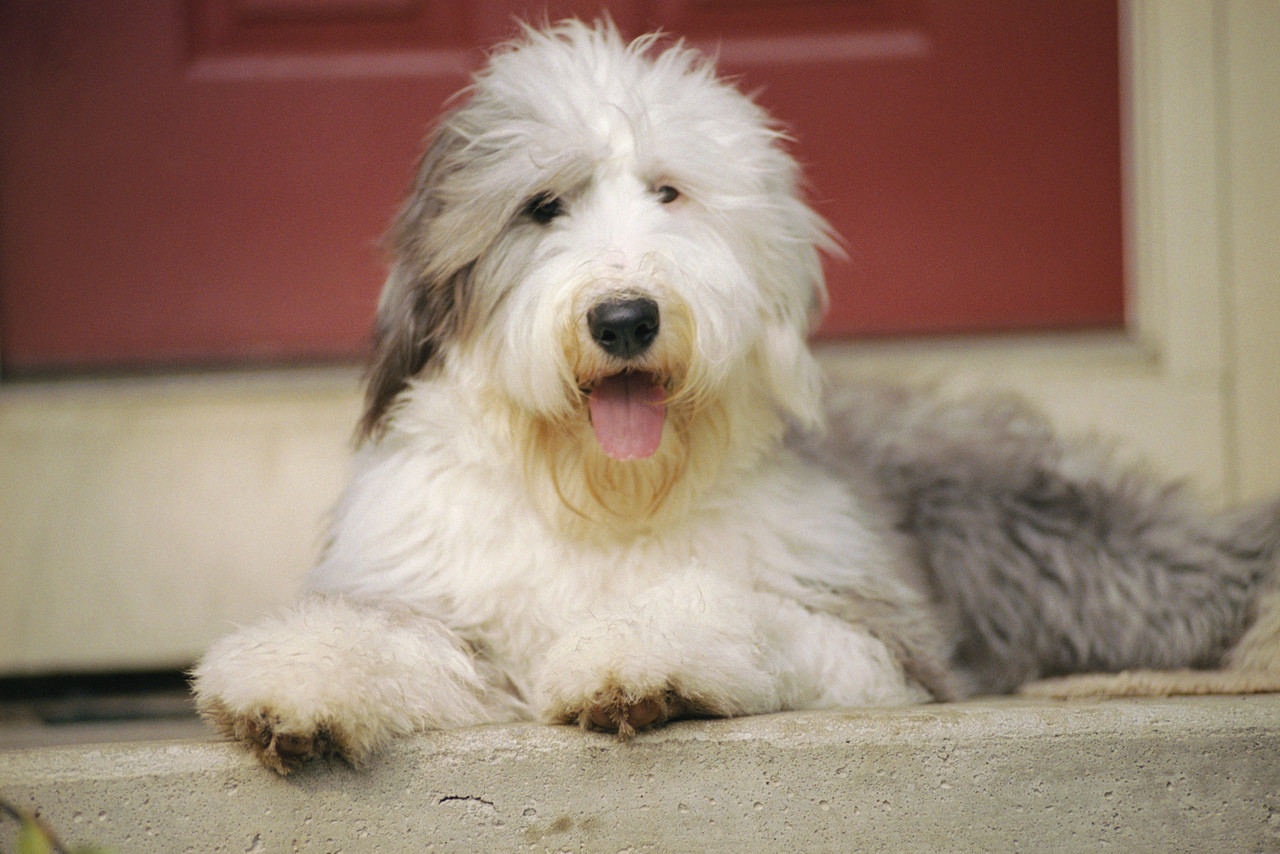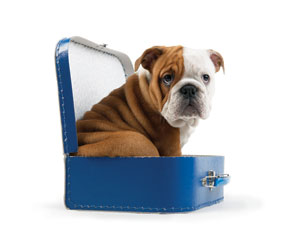 |
 |
 Since puppies are highly social creatures, being alone can be quite
stressful for them. Fortunately, you can teach your pup to enjoy his
alone time, or at least tolerate it. If he never grasps how to do this,
you may end up with a dog who acts out through excessive barking,
digging, and chewing - or develops a very serious case of separation
anxiety. Since puppies are highly social creatures, being alone can be quite
stressful for them. Fortunately, you can teach your pup to enjoy his
alone time, or at least tolerate it. If he never grasps how to do this,
you may end up with a dog who acts out through excessive barking,
digging, and chewing - or develops a very serious case of separation
anxiety.
When you leave your pup alone, make sure he's in a safe place--either a
roomy crate or a secluded, puppy-safe, space. Puppies should be "crate trained" whenever you leave the house, until
they're about a year old, though some dogs may need more time.
Before
your pup goes into his crate, make sure all his needs
are met--that he's been walked or let out, has had some playtime, and
has food and water. If he cries, at least you know his basic needs have
been attended to. With time and proper training, your pup will begin to
adjust to being alone, and start to understand that you will always
return.
Steps to teaching your puppy to be alone:
1.
Leave your pup alone in his crate or secluded, puppy-safe space for at
least 30 minutes to an hour each day. Gradually increase that length of
time to up to 2 hours for pups 3 months and younger, or up to 4 hours
for a 3-6 month old pup.
2. Make your pup's alone time the main
time he eats, and he'll learn to enjoy these stretches more. Leave him
with a couple of stuffed chew toys to make the experience more
pleasant.
3. Once in a while, interrupt his playtime with
short, quiet breaks. Teach your dog that quiet time is a good thing by
telling him to "settle down," and lie still for a second or two. Then
reward him and continue playing. When your pup is able to settle
successfully for these brief periods, slowly build up to longer
segments. Your dog will soon learn that quiet time is followed by
playtime, and the wait is never more than he can handle.
|
|
 |
 Many pet owners wonder whether it's safe to dispense over-the-counter,
"people" medicines to their cats and dogs. The fact of the matter is,
some human
medications such as Tylenol (acetaminophen) can be toxic, and even
lethal to pets.
Pound-for-pound, doses for animals are not always the same as for
people. You could very easily overdose or underdose your pet. In
addition, your pet may have a medical condition which could be worsened
by the use of some human medications. As a rule, you should never use
over-the-counter human medications on your pet unless you are advised
to do so by your veterinarian. If your veterinarian does prescribe
them, be sure to follow the dosage instructions exactly as written. Many pet owners wonder whether it's safe to dispense over-the-counter,
"people" medicines to their cats and dogs. The fact of the matter is,
some human
medications such as Tylenol (acetaminophen) can be toxic, and even
lethal to pets.
Pound-for-pound, doses for animals are not always the same as for
people. You could very easily overdose or underdose your pet. In
addition, your pet may have a medical condition which could be worsened
by the use of some human medications. As a rule, you should never use
over-the-counter human medications on your pet unless you are advised
to do so by your veterinarian. If your veterinarian does prescribe
them, be sure to follow the dosage instructions exactly as written.
|
|
More Info about Pets and Medication
|
|
 |
 |
 While your pet is most certainly a part of the family, and it can be a
joy to bring them along for family trips, it can often be a lot more
trouble than it is worth if you're not prepared. Make sure you know all
the ins and outs of traveling with your pet--depending on where you're
going, how long you'll be gone, your method of transportation, health
considerations, etc.--before you undertake the journey. While your pet is most certainly a part of the family, and it can be a
joy to bring them along for family trips, it can often be a lot more
trouble than it is worth if you're not prepared. Make sure you know all
the ins and outs of traveling with your pet--depending on where you're
going, how long you'll be gone, your method of transportation, health
considerations, etc.--before you undertake the journey.
First
and foremost, check to make sure wherever you are staying allows pets.
If you're staying at a hotel or resort, find out about any
restrictions, fees, etc.
Also check for a list of emergency veterinary clinics in the area of your destination.
Rabies
vaccinations are a must for all travel abroad, and for returning to the
United States. Most airlines also require these vaccinations. Check
with your vet for the complete range of vaccinations required, and of
course, check with the airline and country to which you're traveling.
If
you're not traveling by car or plane, domestic travel in the U.S. can
be problematic. While some local transportation authorities may allow
pets, Amtrak and Greyhound buses do not. Therefore, your options for
traveling with a pet are drastically reduced.
How many times
have you seen a small dog sitting in a car on the drivers lap, looking
out the window? Or a cat lying on the floor or back seat? An accident,
or even a sudden stop can send your pet flying. They make special
harnesses for dogs, similar to seatbelts, and a
cat carrier can always be used to transport your cat safely. Of course,
make sure the carrier is also secured with a seatbelt.
A loose
pet in the car can also escape if someone opens the door, so make sure
your pet is secured before someone exits the vehicle.
Many dogs and
cats do not travel well in a car. If this is the case, talk to your vet
about tranquilizers or travel sickness pills. Simply boarding your pet
may be a better alternative, depending on the length of the trip and
the pet's sensitivity to travel.
There have been too many
incidents of cats and dogs suffering from heatstroke after being left
in a hot car. If you must leave your pet in the car, make sure it is
only for a few minutes. Leave at least two windows open slightly to
provide fresh air. However, we strongly recommend that you DON'T leave
animals in the car in hot climates or during the warmer months, as even
a short time in a hot vehicle can be dangerous.
|
|
Pet friendly hotels, campgrounds and more...
|
|
 |
 |
|

Being aware of the needs of your older canine or feline friends makes caring for them
easier, enhances your experience, and increases their quality of life. Here are some tips for doing just that:
Dogs
Moderately exercise your older dog every day. Try not to overdo it. Watch for excess panting and drooping tail.
Feed your dog high quality dog food specific to his dietary needs, as advised by your veterinarian.
Be consistent with your dog's routine and minimize household disruptions and stressful situations.
Groom your dog regularly, checking for lumps and bumps.
Keep your dog flea and parasite free using methods recommended by your vet.
Take
your dog to the vet at least once a year. He or she will screen your
dog for kidney, liver, and pancreatic cancers, and heart disease.
Pet and cuddle your dog frequently to let him know he is loved!
Cats
Visit
your veterinarian at least once a year for recommended vaccinations and
a complete physical examination including a fecal exam, blood work, and
urinalysis.
Prevent your cat from becoming overweight by encouraging exercise and feeding her a proper diet.
Preventative dental health care is a key contributor to increasing both quality and length of life in cats.
Keep your cat flea and parasite-free, using methods recommended by your vet.
Provide
a diet formulated to meet the requirements of older cats. Nutritional
requirements begin to change when your cat reaches about eight years of
age.
Use supplements such as antioxidants, chondroitin sulfate and
glucosamine to help slow the aging process and the onset of joint
disease.
Cats,
especially older cats, like their privacy. Give your cat a warm, cozy
place to take uninterrupted naps away from children and other pets.
Groom
your cat regularly to prevent her from ingesting hair when she grooms
herself. Older cats may not be as fastidious as younger ones.
Prevent your cat from becoming overweight by encouraging exercise and feeding a proper diet.
Keep your cat indoors for health and safety reasons, especially after the age of 12.
Give your cat lots of love and attention every day!
|
|
 |
|
#my_firstname# #my_lastname#
#my_phone#
|
|
|
 |
|
In This Issue:
|
|
 |
|
Contact Us
|
#my_firstname# #my_lastname#
#my_phone#
|

|
|
Cute Pet Video:
|
|

|

|
|
Little Known Pet Facts
|
- An estimated 1 million dogs in the United States have been named the primary beneficiary in their owner's will

- A cat will almost never meow at another cat. Cats use this sound for humans

- Contrary to popular belief, dogs do not sweat by salivating. They sweat through the pads of their feet

- A cat uses its whiskers as feelers to determine if a space is too small to squeeze through

- Dogs can alert their owners of an epileptic seizure up to an hour before it occurs

- A cat can be either right-pawed or left-pawed
|
|
 |